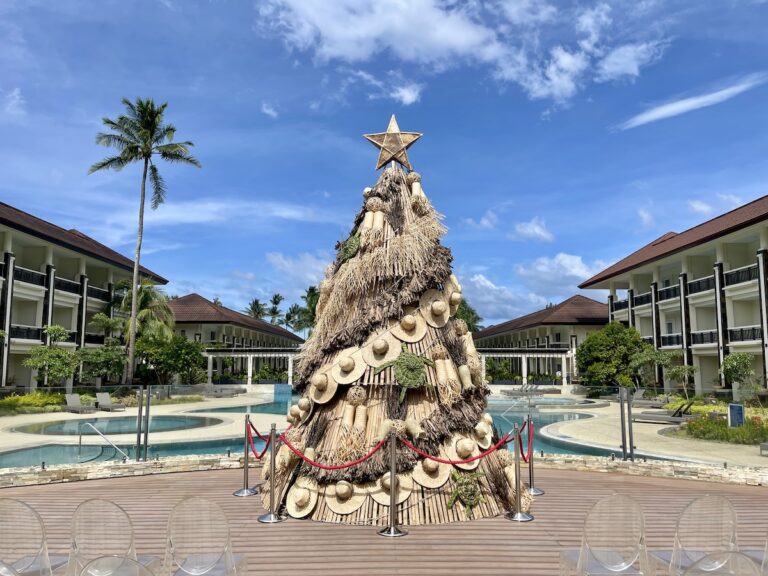Malilipot Abaca Weavers in Brgy. San Roque, Malilipot, Albay
Alemania Weaving Center in Malilipot, Albay: Preserving Traditional Filipino Abaca Textiles
During our recent visit to the Alemania Weaving Center, we were greeted by the vibrant sight of skilled artisans expertly maneuvering their looms. The rhythmic sounds of the looms filled the air, creating a captivating symphony of craftsmanship. With a warm smile, one of the weavers shared a fascinating history of abaca weaving, illuminating its deep roots and significance within the local culture.
Malilipot Abaca Weavers in Brgy. San Roque, Malilipot, Albay
As we engaged with the weavers, we were drawn into their world, discovering the intricacies of their tools and the precise techniques they employed. Each vibrant thread told a story, and the meticulous process revealed not just the artistry but also the passion and dedication that went into creating each exquisite piece. The atmosphere was alive with the spirit of tradition and creativity, leaving us in awe of the mastery on display.
Located in a quiet village in Malilipot, Albay, the Alemania Weaving Center stands as a testament to the rich weaving tradition of the town. Known for its exquisite pinukpok cloth, this weaving center offers fabric that is three times stronger than both cotton and silk. The Alemania Weaving Center is the only place in the region that produces pinukpok cloth, showcasing the unique skill and dedication of local artisans.
The center plays a crucial role in maintaining the abaca weaving artistry of Albay while also providing economic opportunities for the local community. By employing traditional methods to manually pound abaca fibers, the weavers create a fabric that is both fine and silky. Pinukpok fabric weaving not only boosts the region’s craft industry but also supports the livelihood of many families.
Visitors to Albay might be drawn to its iconic Mayon Volcano, but the craftsmanship found at the Alemania Weaving Center offers an equally compelling reason to explore the area. The vibrant textiles produced here reflect the resilience and creativity of Albay’s people, making it a key destination for those interested in the arts and culture of the Philippines.
Origins of Abaca Weaving in Malilipot
The use of abaca fibers in Malilipot dates back many years, reflecting the area’s deep connection to this natural material. Abaca, often referred to as Manila hemp, is prized for its strength and durability. It grows abundantly in the Bicol region and has been a crucial part of local livelihoods for generations.
Craftsmen in Malilipot have honed their skills over time, developing unique techniques in processing and weaving abaca. The tradition of using these fibers provides a sustainable option for creating a variety of products, ranging from clothing to home decor. The Alemania Weaving Center has played a central role in preserving these practices, ensuring that the artistry of abaca weaving continues to thrive.

Evolution of the Weaving Center
The Alemania Weaving Center was founded to keep the weaving traditions alive and offer support to local artisans. Over the years, it has grown from a small cottage industry into a renowned establishment within Albay. The center provides vital training and resources to weavers, helping them refine their craft and expand their reach.
Its focus on quality and innovation has led to the development of pinukpok cloth, a fabric known for being three times stronger than regular cotton and silk. By combining traditional methods with modern techniques, the center not only preserves cultural heritage but also supports the economic well-being of the community. This dedication has cemented its reputation as a vital contributor to the region’s rich artisanal landscape.
Abaca in the Bicol Economy
The Bicol Region plays a pivotal role in the flourishing abaca industry of the Philippines, renowned for its vibrant agricultural landscape. Abaca, often referred to as Manila hemp, is not just any plant; it is a vital cash crop that significantly supports the livelihoods of countless local farmers, weaving together their hopes for a prosperous future. The Philippines proudly boasts an impressive 84% share of the global abaca fiber production, establishing itself as the leading source of this valuable natural resource. Within this context, Albay stands out as a crucial hub for abaca trade, bustling with activity and trade, as it connects farmers to markets both local and international.
The economic impact of abaca extends beyond the fields; abaca and its myriad products have consistently generated significant foreign exchange for the Philippines. This places the country in a unique position within the global market, as it is one of only two nations capable of producing this exceptional fiber. The other producer, Ecuador, continues to complement the Philippines’ efforts, but it is the Philippines that leads in both quality and quantity, underscoring the importance of abaca in the nation’s agricultural heritage and economic stability.
Abaca farming and processing create numerous jobs, supporting rural communities. Products made from abaca include ropes, textiles, and handmade paper, which are exported globally, boosting the local economy. The industry’s significance is underscored by its resilience in the face of challenges like pests and diseases, which the local farmers continually overcome to sustain production.
Cultural Significance of Abaca
Abaca holds deep cultural significance in the Bicol Region, where its fibers represent more than materials—they embody tradition and community identity. This remarkable fiber reflects rich craftsmanship and heritage, passed down through generations.
At places like the Alemania Weaving Center in Malilipot, Albay, abaca weaving is celebrated as a vital expression of local culture. The intricate techniques and vibrant patterns tell stories of local legends and history, transforming each piece into a narrative tapestry.
Beyond preserving traditions, abaca weaving fosters community gatherings through lively festivals and exhibitions, instilling pride and strengthening local bonds. Thus, abaca serves as a powerful symbol of cultural continuity and community spirit in Bicol.

Abaca Fiber Production Process
Producing abaca fiber involves several meticulous stages. Initially, farmers harvest the abaca plant, which is then stripped to extract fibers. These fibers undergo cleaning and are manually pounded to create a fine, smooth finish, as produced by the Alemania Weaving Center.
The fibers are dried and then woven into various products, like fabrics and ropes. The process is labor-intensive, requiring skill and patience. Workers, often skilled artisans, ensure that each step preserves the fiber’s quality, making the abaca products highly valued. This traditional process supports the economic and cultural livelihood of Bicol’s people, showcasing their expertise and dedication.
Woven Products and Their Uses
The weaving center produces a range of items made from abaca fibers, which are known for their strength and durability. These products include barongs, ternos, and even household items like bags and decorative pieces. Abaca is valued globally, as it is one of the world’s strongest natural fibers, suitable for creating items that are both practical and stylish.
Other popular woven products include ropes, packaging materials, and home decor. These items are sought after not just for their aesthetic appeal but also for their functional uses. People around the world appreciate these products’ quality, showcasing the versatility of abaca weaving in both fashion and everyday life.

Artistry in Abaca Weaving
Artistry is at the core of abaca weaving at Alemania Weaving Center. Each piece is crafted with precision, embodying traditional techniques that have been passed down for generations. The weavers use manual pounding methods to enhance the fibers, creating a fabric that is smooth, silky, and stronger than cotton or silk.
The handcrafted approach allows for intricate and one-of-a-kind designs. Abaca’s adaptability enables artisans to explore various patterns and textures, ensuring each product is unique. This dedication to artistry is evident in the finished products, from clothing to decorative arts, exemplifying the high level of skill involved in this traditional craft.
Visiting Alemania Weaving Center
How to Get There
Alemania Weaving Center is situated in Malilipot, about an hour’s drive from Legazpi City. Visitors traveling from Legazpi can take a bus or jeepney heading to Tabaco City and ask to be dropped off at Malilipot. Alternatively, hiring a private car or taking a taxi provides more comfort.
For those coming from farther locations, the nearest airport is in Legazpi City. Flights to Legazpi are available from Manila. Upon arrival, visitors can hire transport from the airport to Malilipot. It’s helpful to check road conditions and transport schedules in advance as these can vary.
Supporting Local Weavers
Supporting local weavers is essential for preserving this traditional craft. Visitors can purchase a wide range of handmade products such as scarves, bags, and home decor items directly from the weaving center. These purchases help sustain the weavers and ensure the continuation of this cultural heritage.
Impact on Local Community and Beyond
Economic Benefits to Malilipot
The weaving center creates jobs for many local residents. By producing pinukpok cloth, it offers work to artisans who are skilled in this traditional craft. The center also attracts tourists and buyers from other regions, boosting local businesses like shops and eateries. This flow of visitors helps increase sales, improving the overall economy of Malilipot.
Through these combined efforts, the weaving center stands as a key player in revitalizing the local economy and connecting it to broader markets.
Community Based Tourism
The Tourism Promotions Board, serving as the marketing arm of the Department of Tourism, has committed its support to the abaca industry, fostering the development of exceptional, world-class products. By promoting community-based enterprises, the TPB not only encourages local artisans to market their beautifully crafted goods but also invites tourists to visit abaca weaving sites. This initiative provides travelers with a unique and immersive experience, allowing them to witness the intricate art of abaca weaving firsthand while appreciating the rich cultural heritage behind each handcrafted item.

Frequently Asked Questions
What are the operating hours of the textile weaving center in Malilipot, Albay?
The Alemania Weaving Center is generally open to visitors throughout the week. Exact operating hours may vary, so it is recommended for visitors to contact the center directly for the most accurate information.
What type of weaving techniques can be learned at the textile center in Malilipot, Albay?
At the center, visitors can learn about traditional weaving techniques using abaca fibers. These techniques include creating pinukpok cloth, a fabric known for its fine, smooth texture and durability.
Can visitors participate in hands-on weaving workshops at the Malilipot weaving center?
Yes, visitors to the Alemania Weaving Center often have the chance to engage in hands-on weaving workshops. These workshops allow participants to experience the craft firsthand and learn from skilled artisans.
Are there any cultural significance or history tours available at the weaving center?
The center offers insights into the cultural significance of weaving in Albay. While specific tours highlighting history may not be officially outlined, staff and artisans often share stories and information on the tradition and heritage of their craft.
What items are typically available for purchase at the Malilipot weaving center?
Visitors can purchase various handwoven items, including textiles made from abaca fibers. These products often include clothes, fabrics, and decorative items, showcasing the unique quality of the locally produced pinukpok cloth.
Are there any accommodation facilities nearby for tourists visiting the weaving center?
There are accommodation options available near the weaving center. Local inns and guesthouses provide convenient stays for those exploring the crafts and traditions of Malilipot, making it easy for tourists to visit and experience the weaving center.
Follow and Subscribe to OutofTownBlog.com on Facebook, Twitter, Instagram, Pinterest, and YouTube for more Travel related updates.
Read: Abaca Festival: Catanduanes pays homage to the Abaca







